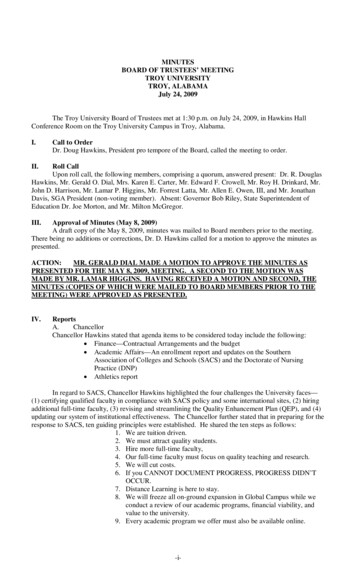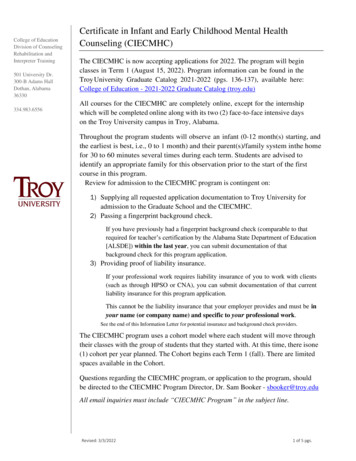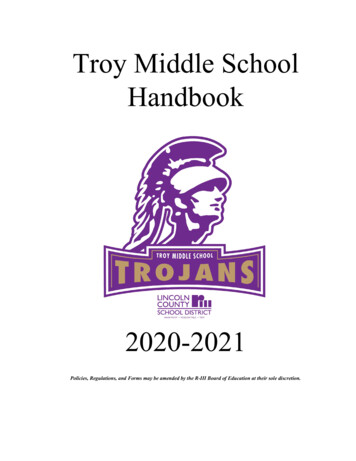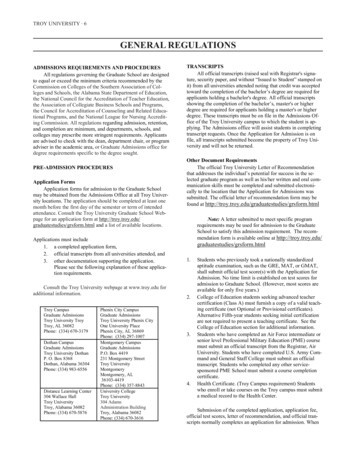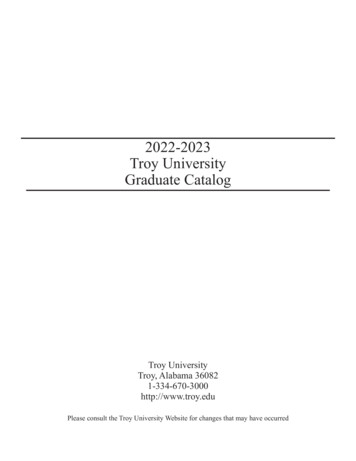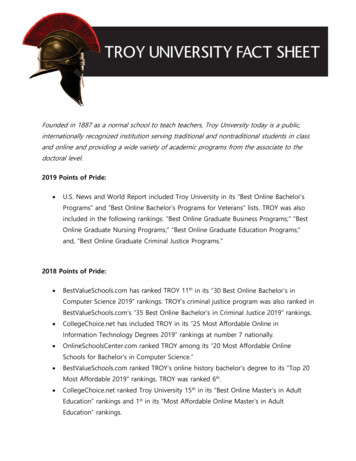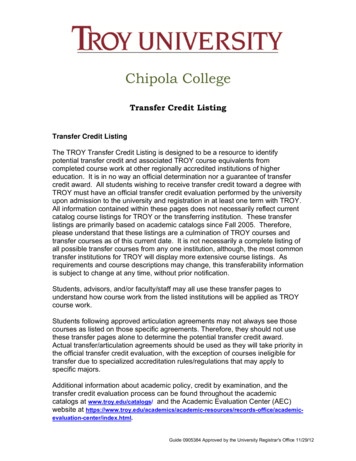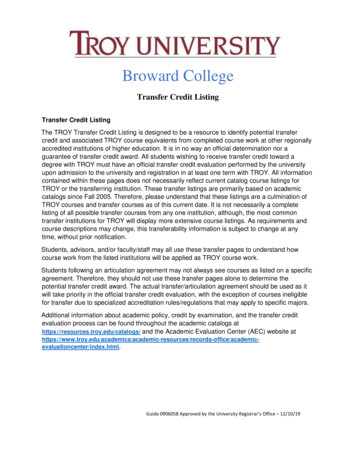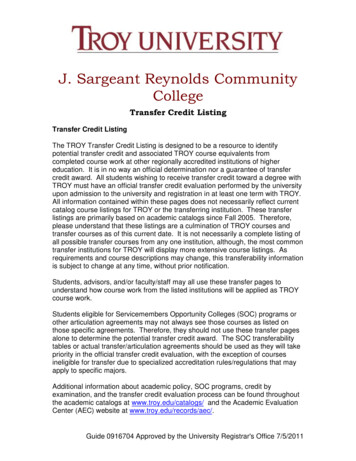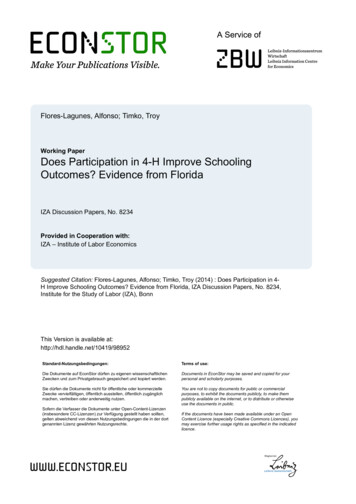
Transcription
Flores-Lagunes, Alfonso; Timko, TroyWorking PaperDoes Participation in 4-H Improve SchoolingOutcomes? Evidence from FloridaIZA Discussion Papers, No. 8234Provided in Cooperation with:IZA – Institute of Labor EconomicsSuggested Citation: Flores-Lagunes, Alfonso; Timko, Troy (2014) : Does Participation in 4H Improve Schooling Outcomes? Evidence from Florida, IZA Discussion Papers, No. 8234,Institute for the Study of Labor (IZA), BonnThis Version is available ngsbedingungen:Terms of use:Die Dokumente auf EconStor dürfen zu eigenen wissenschaftlichenZwecken und zum Privatgebrauch gespeichert und kopiert werden.Documents in EconStor may be saved and copied for yourpersonal and scholarly purposes.Sie dürfen die Dokumente nicht für öffentliche oder kommerzielleZwecke vervielfältigen, öffentlich ausstellen, öffentlich zugänglichmachen, vertreiben oder anderweitig nutzen.You are not to copy documents for public or commercialpurposes, to exhibit the documents publicly, to make thempublicly available on the internet, or to distribute or otherwiseuse the documents in public.Sofern die Verfasser die Dokumente unter Open-Content-Lizenzen(insbesondere CC-Lizenzen) zur Verfügung gestellt haben sollten,gelten abweichend von diesen Nutzungsbedingungen die in der dortgenannten Lizenz gewährten Nutzungsrechte.If the documents have been made available under an OpenContent Licence (especially Creative Commons Licences), youmay exercise further usage rights as specified in the indicatedlicence.
SERIESPAPERDISCUSSIONIZA DP No. 8234Does Participation in 4-H Improve Schooling Outcomes?Evidence from FloridaAlfonso Flores-LagunesTroy TimkoJune 2014Forschungsinstitutzur Zukunft der ArbeitInstitute for the Studyof Labor
Does Participation in 4-H Improve SchoolingOutcomes? Evidence from FloridaAlfonso Flores-LagunesBinghamton University (SUNY)and IZATroy TimkoIndependent ResearcherDiscussion Paper No. 8234June 2014IZAP.O. Box 724053072 BonnGermanyPhone: 49-228-3894-0Fax: 49-228-3894-180E-mail: iza@iza.orgAny opinions expressed here are those of the author(s) and not those of IZA. Research published inthis series may include views on policy, but the institute itself takes no institutional policy positions.The IZA research network is committed to the IZA Guiding Principles of Research Integrity.The Institute for the Study of Labor (IZA) in Bonn is a local and virtual international research centerand a place of communication between science, politics and business. IZA is an independent nonprofitorganization supported by Deutsche Post Foundation. The center is associated with the University ofBonn and offers a stimulating research environment through its international network, workshops andconferences, data service, project support, research visits and doctoral program. IZA engages in (i)original and internationally competitive research in all fields of labor economics, (ii) development ofpolicy concepts, and (iii) dissemination of research results and concepts to the interested public.IZA Discussion Papers often represent preliminary work and are circulated to encourage discussion.Citation of such a paper should account for its provisional character. A revised version may beavailable directly from the author.
IZA Discussion Paper No. 8234June 2014ABSTRACTDoes Participation in 4-H Improve Schooling Outcomes?Evidence from Florida 1We examine the effect of participation in 4-H, the largest youth development program in theUnited States, on standardized test scores. We do this by utilizing grade-level longitudinaldata on Florida’s school districts from the Florida Department of Education combined with 4H participation statistics from Florida 4-H. Specifically, we analyze the effect of the extent of4-H participation for third through tenth grade on the mathematics and reading subtests of theFlorida Comprehensive Assessment Test (FCAT). We use a difference-in-difference-indifferences (DDD) approach to control for potential confounders of the causal relationship atthe level of school districts, grades, and years. Our results indicate that the extent of 4-Hparticipation at the district-grade-year level is positively and significantly related to severalmeasures of performance on the FCAT test.JEL Classification:Keywords:I21, I28, H524-H program, Florida, standardized test scoresCorresponding author:Alfonso Flores-LagunesDepartment of EconomicsBinghamton University (SUNY)P.O. Box 6000Binghamton, NY 13902-6000USAE-mail: aflores@binghamton.edu1We thank Marilyn Norman, Nancy Johnson, Joy Jordan and Keith Diem from Florida 4-H for theirhelp in obtaining the 4-H data and in understanding the 4-H organization. We also thank Kim Wardand Alice Raker, Program Specialists at the Florida Department of Education, for their help inacquiring and understanding the Florida Schools Indicator Report data. Useful comments have beenprovided by Vikesh Amin, Rick Ashley, Carmen Carrion-Flores, Damon Clark, Larry Kenny, ChrisParmeter, Sol Polacheck, Sue Stockly, participants at Binghamton University’s labor group, seminarparticipants at Virginia Tech and The Ohio State University, and participants at the 2010 SouthernEconomics Association and the 2009 Agricultural and Applied Economics Association Meetings. Anyerrors or misinterpretations are our responsibility.
4-H is the largest youth development organization in the United States, with over sixmillion young Americans participating in the various programs it offers, such asorganized clubs, day camps, and school enrichment programs (4-H 2009).2 4-H has apresence in every county and state in the United States, partnering with universitieswithin the Land Grant University System. This organization traces back its origins to1902, when it provided a link between public school education and rural communities,and for this reason it is widely regarded as agriculturally-focused (4-H 2009). However,since the 1950s, it has spread into urban areas and its focus has shifted towards life skillsdevelopment of youth. Today, “4-H'ers participate in fun, hands-on learning activities,supported by the latest research of land-grant universities, that are focused on three areascalled mission mandates: science, engineering, and technology; healthy living; andcitizenship” (4-H 2009).3 Examples of specific programs are Science Discovery, PublicSpeaking, Citizenship, Real Money Real World, Health Rocks! and Leadership. Given 4H’s links to institutions of higher education and its remarkable reach and scope, it islikely that the program has a noticeable effect on America’s youth. Additionally, thesesame characteristics strategically position 4-H to be a key player in future youthdevelopment policies, and may also give the organization the potential of complementingthe educational efforts of the public school system.Perhaps surprisingly given the discussion above, economists have paid littleattention to analyzing the 4-H program. A plausible explanation for this is the lack ofreadily available individual-level data containing 4-H participation and relevantoutcomes. To our knowledge, evidence of the effects of the 4-H program has largelytaken the form of surveys of opinions and perceptions provided by 4-H members andtheir families or 4-H volunteers (e.g., Guion 2002) or by comparing outcomes of 4-H2The name 4-H stands for “Head, Heart, Hands, and Health”. The 4-H pledge reflects these words: “Ipledge my head to clearer thinking, my heart to greater loyalty, my hands to larger service and my healthto better living for my club, my community, my country and my world”.34-H considers itself a Youth Development Program (YDP). In general, YDPs “ are programs thatprovide opportunities and support to help youth gain the competencies and knowledge they need to meetthe increasing challenges they will face as they mature” (Roth et al., 1998). YDP’s goals lie at the heart ofthe positive youth development approach (see, e.g., Carnegie Council on Adolescent Development, 1989).2
participants and non-participants (e.g., Goodwin, Carroll and Oliver 2005), typicallyfinding positive effects on youth.4 However, common omissions in this literature are theuse of objective measures of student performance and, more importantly, the use ofproper controls for systematic differences between participants and non-participants thatmay confound the causal relationship between 4-H participation and youth’s outcomes.5Analyzing the causal link between 4-H participation and youth outcomes isimportant to assess its effectiveness. This is of interest for several reasons. First, the 4-Hprogram can be seen as an additional input to the formal educational process (e.g., the“educational production function”), since the program is intended to have an effect on theyouth development aspects that affect student performance (e.g., student health andbehavior). As such, it is important to quantify its effect on the production of education, asmeasured by academic outcomes. Second, given its wide reach and scope, 4-H isstrategically positioned to complement the improvement efforts of public school districts,potentially helping them succeed in the context of intense competition for resources andaccountability provided by the No Child Left Behind (NCLB) Act of 2001. Within thisbackground, it is of interest to analyze whether the 4-H program results in noticeableeffects on standardized test scores, which is the main measure employed by the NCLBAct for school accountability. Finally, the 4-H program itself has faced challenges injustifying its existence to funders of the program (e.g., Farmer 2010; Murray 2010).Producing reliable estimates of the causal effects of 4-H on objective outcome measuresis important in this policy issue.For these reasons, we examine the effect of 4-H participation on standardized testscores in the state of Florida. Given the non-availability of suitable individual-level data,we collected grade-level longitudinal information on Florida’s school districts from theFlorida Department of Education and combined it with 4-H participation statistics fromFlorida 4-H. Specifically, we analyze the effect of the extent of 4-H participation—4Examples of findings reported in these studies are that 4-H participants are less likely to use drugs, have abetter outlook on life, report that they get better grades, and have better leadership and oral skills.5A notable exception is the longitudinal 4-H Study of Positive Youth Development (e.g., Lerner et al.2009), described in the next section.3
defined as the proportion of students who participate in 4-H—for third through tenthgrade on the average scores and passing rates in the mathematics and reading subtests ofthe Florida Comprehensive Assessment Test (FCAT). In order to control for the likelypresence of unobserved confounding factors, we estimate the causal link between theextent of 4-H participation and FCAT scores employing a difference-in-difference-indifferences (DDD) approach. This method allows controlling for unobserved confoundersthrough school district, grade level, and school year fixed effects, as well as interactionsamong them, thus focusing on the variability in the extent of 4-H participation in districtgrade-year cells.Although 4-H does not explicitly design its programs with the intention ofincreasing standardized test scores for its participants, there are several reasons to expect4-H to influence test scores. First, 4-H programs are based upon its three missionmandates (science, engineering and technology; healthy living; and citizenship) and thusthey aim to positively engage students in utilizing scientific reasoning, practicing healthybehaviors, and interacting in a positive manner with their peers and mentors (4-H 2009).All of these actions can have positive effects on academic performance. Second, thescience, engineering and technology programs are designed with the experiential learningprocess in mind such that participants are encouraged to think, make choices, and reflecton what they have learned. This type of learning helps engage students in the learningprocess rather than passively absorbing knowledge (4-H 2007a), which increases theoverall interest in academic subjects. Third, encouraging students to make healthylifestyle choices likely enhances their school performance. Practicing healthy habitspromotes healthy growth and helps students resist disease (Silliman 2007; Satcher 2001),likely leading to fewer missed school days. In turn, children who miss a large number ofschool days achieve poorer academic outcomes (Grossman and Kaestner 1997).6 Finally,positive behaviors related to good citizenship and non-cognitive skills in general have6The effects of healthy choices on test scores are perceivable even in the short-run. For instance, Figlio andWinicki (2005) document that simply changing school feeding programs to provide nutritional advantagesto children on test days have effects on test performance.4
also been related to better performance on standardized tests and schooling (e.g., Wentzel1993; Heckman, Stixrud and Urzua 2006).Our study relates to recent literature analyzing after-school programs (ASPs).There has been an increasing interest in the availability and the effects of ASPs in theUnited States, both in the policy arena (e.g., Carnegie Council on AdolescentDevelopment 1992) and in academic research circles (e.g., Hollister 2003; Kane 2004;Roth et al. 1998). A widely cited cause for this is the concern for the amount of time thatstudents spend on their own after regular school hours (e.g., Hollister 2003). Forexample, it has been documented that students without adult supervision after school aremore likely to engage in undesirable activities (Azier 2004);7 and that shorter schooldays—resulting in more after school time—are related to higher juvenile property crime(Jacob and Lefgren 2003). Another important cause is the surge in test-basedaccountability at schools (e.g., Kane 2004) that coincides with the passage of the NCLBAct. Against this backdrop, after-school programs are seen as devices that cansimultaneously keep students away from potentially risky behaviors and teach themuseful skills. While not completely fitting the blueprint of a typical after-school program(such as those reviewed by Kane 2004), a share of 4-H programs take place after schoolhours and accomplish similar objectives.8Our results indicate that the extent of 4-H participation at the district-grade-yearlevel is positively and significantly related to several measures of performance on boththe mathematics and reading subtests of the FCAT. In particular, in our preferred model,we find that the extent of 4-H participation in the same school year has a statisticallysignificant positive effect on the average score on the reading subtest of the FCAT, aswell as on passing rates (level 3 or above out of 5) on both the mathematics and readingsubtests. The extent of participation in 4-H is also significantly related to a decrease in7The undesirable activities include skipping school, use of alcohol or marijuana, stealing, or hurtingsomeone.8The ASPs reviewed by Kane (2004) are 21st Century Community Learning Centers, The After SchoolCorporation, Extended-Service School Initiative, and San Francisco Beacons Initiative. These are allpublicly funded programs and their scale is much smaller than 4-H.5
the proportion of students who score in the lowest level of the mathematics subtest, andto an increase in the proportion who score in the highest level of the reading subtest. Theeffects we uncover appear of a reasonable magnitude as compared to estimates of thecausal effect of other inputs into the educational production function (e.g., Krueger1999).Finally, we also explore whether the effects of 4-H participation appear toaccumulate over time, and how these estimated effects vary when considering differentcharacteristics of the district-grade-year cells, such as their relative racial/ethniccomposition and their rural or urban nature.BackgroundWe begin by providing relevant details about the 4-H program, selectively reviewingliterature relevant to our study, and providing information about the FloridaComprehensive Assessment Test (FCAT), our outcome of interest.The 4-H Program4-H serves over six million young Americans, making it the largest youth developmentorganization in the United States.9 As a youth development program, 4-H’s mission is to“empower youth to reach their full potential through working and learning in partnershipwith caring adults”. It accomplishes this goal with the help of over 3,500 employees and518,000 volunteers who deliver a wide array of programs, such as organized clubs,school enrichment programs, and day camps. 4-H programs operate in every county andstate in the United States, as well as in more than 80 countries around the world, inpartnership with 106 land-grant universities (4-H 2009). Although 4-H traces back itsorigins in 1902 to an agriculturally-focused program (it started as a link between publicschool education and rural communities), since the 1950s, it has spread into urban areas(4-H 2009). Today, 30 percent of students involved in 4-H reside in cities with more than50,000 residents; 22 percent in towns between 10,000 and 50,000 residents; 36 percent intowns with under 10,000 residents; and 12 percent on farms (4-H 2007b).9As a comparison, 4-H (2007b) reports that the next largest youth development organizations are Boys &Girls Club of America (serving 4.8 million), Boy Scouts of America (2.8 million), Girl Scouts USA (2.6million), Future Farmers of America (508 thousand), and Big Brothers Big Sisters (255 thousand).6
4-H has three mission mandates that are at the center of every program it offers:science, engineering and technology; healthy living; and citizenship. Programs in 4-Htake several forms such as school-based, after-school-based, camp settings, and clubs,and span a wide array of topics. Examples of topics include public speaking, leadership,environmental education, citizenship, arts, consumer and family science, foods andnutrition, health, technology, and biological and physical sciences. All of the programsadhere to one of the mission mandates and are centered around 4-H’s “fundamental idealof practical, ‘learning by doing’ experiences [that] encourage youth to experiment,innovate and think independently” (4-H 2009). In terms of organizational structure, “4-His operated and supported [includes financially] by a shared leadership of public andprivate partners, including National 4-H Headquarters; United States Department ofAgriculture (USDA) within the Cooperative State Research, Education and ExtensionService; Cooperative Extension educators at land-grant universities; National 4-HCouncil; 4-H associations and foundations; and volunteers” (4-H 2009). The wide arrayand diversity of stakeholders underscores the importance of evaluations of theeffectiveness of 4-H.The state 4-H programs are independently operated and are associated with theland-grant universities in each state. In Florida, 4-H is part of the Florida CooperativeExtension Service within the University of Florida’s Institute of Food and AgriculturalSciences (UF/IFAS) and Florida A&M University; and receives support from combinedefforts of the county, state, and federal governments (Norman and Jordan 2006). We willdiscuss more about funding sources below in the context of our identification strategy.Florida 4-H offers programs in all of its 67 counties, which correspond exactly to theschool districts in the state. Importantly, the 4-H county offices and school districts areindependent organizations. During the 2007/08 school year, over 263,000 students wereinvolved in Florida 4-H (Florida 4H 2008) at a cost of over 21 million (IFAS Extension2007 Annual Report). Of these members, approximately 47 percent live in suburbs andcities with populations greater than 50,000; 51 percent are female; 63.3 percent are in7
elementary school; 22.7 percent are in middle school; and 9.9 percent are in high school(Florida 4H 2008).10Most of the programs offered by Florida 4-H are delivered through schoolenrichment programs or organized clubs. 11 In school enrichment programs, whichaccount for about 75 percent of programs, 4-H partners with local schools to offer 4-Hprograms (in-school or after-school). 4-H clubs, which account for about 15 percent ofprograms, are groups formed by members around a particular topic and are guided by oneor more adults (employees or volunteers). Generally, the topics of programs in Florida—regardless of the delivery method—fall into one of ten areas: agricultural literacy, animalsciences, career development and workforce participation, citizenship and leadershipeducation, communication sciences and expressive arts, environmental education andearth sciences, healthy lifestyle education, plant science, and science and technology. Allprograms offered by Florida 4-H are guided by the same 4-H principles discussed earlier.Related LiteratureEvidence on the effectiveness of the 4-H program in influencing the lives of its studentparticipants has traditionally taken the form of surveys of opinions and perceptionsprovided by 4-H members and their families or 4-H volunteers, with no informationabout non-participants. The main purpose of these studies—some of them reviewed inGuion (2002)—is to measure participants’ attitudinal and behavioral perceptions aboutdifferent activities within 4-H. More recently, Goodwin, Carroll and Oliver (2005)provide evidence of the impact of 4-H on students by comparing both 4-H participantsand non-participants based on student survey information about their perceptions of theirown performance levels. Their study finds that 4-H members are less likely to use drugs,have a better outlook on life, and self-report obtaining better grades than non-4-H10About 4 percent of members are in Kindergarten.Other delivery methods include day camps and special interest clinics, school-age child care, andovernight camping. Together, these represent less than 10 percent of programs.118
members. These studies likely fall short from establishing causal links given the absenceof proper controls for systematic differences between participants and non-participants.A study worthy of note is the 4-H Study of Positive Youth Development (seeLerner et al. 2009 and references therein), a longitudinal study that followed childrenover five years, beginning in 2002. The original sample included 1,719 fifth graders whowere surveyed about their behaviors and participation in 4-H and other programs. Tocontrol for self-selection into programs, 4-H participants are matched to non-participantsusing a variety of covariates (Lerner et al. 2009). While the main focus of the study is onthe effect of participation in 4-H on different aspects of the theory of Positive YouthDevelopment (e.g., changes in a student’s character, confidence, caring, etc.), estimatedeffects on some schooling measures were reported. For instance, Lerner et al. (2009)report that “ 4-H participants had better grades, were more behaviorally andemotionally engaged with school, and were more likely to see themselves going tocollege.” In contrast to this study, we focus on district-grade-year cells given our lack ofaccess to individual-level data, and concentrate in the average cell score on astandardized test score (FCAT) representative of the type of objective performancemeasures employed by the NCLB Act.A related body of literature pertains to the effectiveness of after-school programs(ASPs). These ASPs are very heterogeneous, varying in their primary objectives, costs ofattendance, available methods of delivery, etc. Relative to 4-H, they are typicallynarrower in scope and scale. However, the findings reported about ASPs can help formour expectations about the potential effects of 4-H. Correspondingly, by examining theoverall effect of a more general and widely available program, such as 4-H, we can shedadditional light on the effectiveness of ASPs. Kane (2004) reviews and interprets theresults of evaluations of four different ASPs.12 He notes that none of the evaluationsreported a statistically significant impact on test scores after one year of participation, andargues that this may be due to a lack of statistical power in those studies—which12The four different ASPs are: 21st Century Community Learning Centers, The After-School Corporation,Extended-Service Schools Initiative, and San Francisco Beacons Initiative.9
typically are based on small sample sizes—and to the low “intensity” of participation inthe programs. In contrast, he reports that the evaluations find positive effects of ASPs onparental involvement in school and higher student homework completion. Hollister(2003) reviews ten evaluations of ASPs with “rigorous methodology” (defined as basedat least partially on randomization), and concludes that there have been some effectiveprograms with positive impacts on in-school outcomes such as test scores, and out-ofschool outcomes such as drug and alcohol use or crime. Hollister (2003) finds thatprograms emphasizing mentoring and tutoring are more effective than those emphasizingremedial skill-building and parental involvement.13Other studies analyze the relationship between after-school time and studentoutcomes. For instance, Azier (2004) analyzes the effects of having any kind of adultsupervision after school on various outcomes of students from ten to fourteen years ofage. Using fixed-effects methods to control for unobserved family characteristics, Azierfinds that adult supervision has a negative and significant relationship with incidents ofrisky behavior, such as skipping school, using alcohol or marijuana, stealing, or hurtingsomeone. Jacob and Lefgren (2003) employ exogenous variation in the school calendarsprovided by teacher-in-service days and information on criminal activity to documentthat shorter school days—resulting in more after-school time—are related to higherjuvenile property crime. Interestingly, they also find that shorter school days are relatedto lower rates of violent juvenile crime, which they attribute to the decreased level ofinteraction among students that is provided by schools, which gives fewer opportunitiesfor this type of crime to take place. The findings of these studies relate to 4-H since theprogram simultaneously provides a setting in which students are guided and mentored byadults and receive positive academic and behavioral skills.The Florida Comprehensive Assessment Test (FCAT)13Examples of programs that emphasize mentoring and tutoring are: Big Brothers Big Sisters, Quantum ofOpportunities, and Woodrock.10
The use of standardized test scores as a means of student evaluation and schoolaccountability has increased in the last two decades. In particular, the passage of theNCLB Act in 2001 required states to develop annual assessment instruments for studentsin grades three through eight. Even though standardized test scores are seen as imperfectassessment measures (e.g., Kane and Staiger 2002), they have been widely adopted tosatisfy the requirement. The Florida Comprehensive Assessment Test (FCAT) is thestate’s explicitly-designed test to assess achievement of the Sunshine State Standards—aset of curricular standards approved by Florida’s State Board of Education in 1996. Since2001, the FCAT has been administered to students in grades three through ten. Accordingto the Florida Department of Education, the two main purposes of the FCAT are toprovide information to (i) parents about the level of mastery of the skills of their childrenand (ii) the public on the status of student education while allowing the public to holdschools and districts accountable for progress (Florida Department of Education 2009).Schools face rewards or sanctions depending on their performance, and there is evidencethat the public pays attention to each individual school’s performance on the FCAT (e.g.,Figlio and Lucas 2004).The data available to us on FCAT scores pertain to tests in readingcomprehension (hereafter “Reading”) and mathematics problem solving (hereafter“Mathematics”) measuring individual student performance against national norms(Florida Department of Education 2009). The scores in these tests map into a 5-levelscale, with a performance level of 3 or higher considered to be an “on grade” level. Weconsider this “on grade” level to be a “passing score” for the purpose of our analysis.Importantly, during the school years spanned by our data, there were no significantchanges in the thresholds defining the 5-level FCAT scale.As previously discussed, even though 4-H does not explicitly design its programswith the intention of increasing standardized test scores for its participants, there arespecific reasons to expect a positive relationship between 4-H participation and testscores. Generally speaking, one can regard the 4-H program as an additional input into11
the “education production function,” just as is the case with traditional school resources.14Under this view, when existing alongside school instruction and other basic resources, 4H promotes student learning that can be reflected in measures of academic performancesuch as standardized test scores. As such, 4-H can enhance the efforts of teachers andschools to improve student performance. Focusing on standardized test scores providesan objective measure of student performance, and also offers the advantage that they candirectly be related to earnings later in life (e.g., Murnane, Willet and Levy 1995) and toeconomic growth rates (Hanushek and Kimko 2000), providing a way to relate estimatedimpacts of 4-H on test scores with expected economic benefits.DataIn the absence of individual-level data containing both participation in 4-H andstandardized test scores, we collected longitudinal
Development 1992) and in academic research circles (e.g., Hollister 2003; Kane 2004; Roth et al. 1998). A widely cited cause for this is the concern for the amount of time that students spend on their own after regular school hours (e.g., Hollister 2003). For
